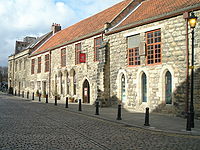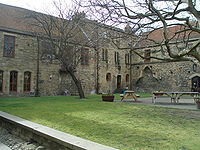
Blackfriars, Newcastle
Encyclopedia

Newcastle upon Tyne
Newcastle upon Tyne is a city and metropolitan borough of Tyne and Wear, in North East England. Historically a part of Northumberland, it is situated on the north bank of the River Tyne...
, Tyne and Wear
Tyne and Wear
Tyne and Wear is a metropolitan county in north east England around the mouths of the Rivers Tyne and Wear. It came into existence as a metropolitan county in 1974 after the passage of the Local Government Act 1972...
, England
England
England is a country that is part of the United Kingdom. It shares land borders with Scotland to the north and Wales to the west; the Irish Sea is to the north west, the Celtic Sea to the south west, with the North Sea to the east and the English Channel to the south separating it from continental...
. It is in the city centre, close to the city's Chinatown
Chinatown, Newcastle
The Chinatown in Newcastle is a district of Newcastle upon Tyne, located to the west of the city on the edge of the shopping and commercial centre, mostly along Stowell Street...
.

Early history
During the early years of the 13th century, orders of friars began to establish themselves in England. Newcastle came to have five friaries within its walls: Blackfriars (DominicanDominican Order
The Order of Preachers , after the 15th century more commonly known as the Dominican Order or Dominicans, is a Catholic religious order founded by Saint Dominic and approved by Pope Honorius III on 22 December 1216 in France...
) established in 1239; Whitefriars (Carmelite) established in 1262; Austinfriars (Augustinian
Order of Saint Augustine
The Order of St. Augustine —historically Ordo Eremitarum Sancti Augustini", O.E.S.A.), generally called Augustinians is a Catholic Religious Order, which, although more ancient, was formally created in the thirteenth century and combined of several previous Augustinian eremetical Orders into one...
) established in 1290 (now the site of the Holy Jesus Hospital
Holy Jesus Hospital
The Holy Jesus Hospital is a museum and tourist attraction in Newcastle upon Tyne, England in the care of the National Trust.The site of the hospital has been in use for 700 years helping the townspeople, and this history is explained by the museum currently on the site...
); Greyfriars (Franciscans) established in 1274 and the Trinitarians
Trinitarian Order
The Order of the Holy Trinity is a Catholic religious order that was founded in the area of Cerfroid, some 80 km northeast of Paris, at the end of the twelfth century. The founder was St. John de Matha, whose feast day is celebrated on 17 December...
established in 1360. There was also the nunnery of St Bartholomew’s founded in 1086 near the present Nun Street.
The Dominican friary was founded by a wealthy Newcastle merchant, Sir Peter Scott. Friars differed from monks, in that worship featured less prominently in the daily routine of the friary. They were clerics who initially lived solely by begging, and they were mostly located in urban areas. They were therefore known as mendicant orders. The Dominican order was founded by St Dominic, also known as Dominic of Osma, shortly after 1200.
Dominicans were forbidden to own buildings and land, but such property could be held in trust for them. Such was the case with Blackfriars, which was situated in the north west of Newcastle just inside the city walls. The friary covered seven acres (2.83 hectares), but also had two gardens and four small closes that provided a small income.
During the 14th century, the friary accommodated royalty on more than one occasion. In 1334 Edward III of England
Edward III of England
Edward III was King of England from 1327 until his death and is noted for his military success. Restoring royal authority after the disastrous reign of his father, Edward II, Edward III went on to transform the Kingdom of England into one of the most formidable military powers in Europe...
and Edward Balliol
Edward Balliol
Edward Balliol was a claimant to the Scottish throne . With English help, he briefly ruled the country from 1332 to 1336.-Life:...
, the claimant to the Scottish throne, met there.
Reformation
During the ReformationEnglish Reformation
The English Reformation was the series of events in 16th-century England by which the Church of England broke away from the authority of the Pope and the Roman Catholic Church....
begun by Henry VIII
Henry VIII of England
Henry VIII was King of England from 21 April 1509 until his death. He was Lord, and later King, of Ireland, as well as continuing the nominal claim by the English monarchs to the Kingdom of France...
in 1536, the five Newcastle friaries and the single nunnery were dissolved and the land was sold to the Corporation and to rich merchants. At this time there were fewer than 60 inmates of the religious houses in Newcastle. The convent of Blackfriars was sold to the mayor and burgesses of Newcastle, who then leased it to nine of the town’s craft guilds, to be used as their headquarters. This probably explains why it is the only one of the religious houses whose building survives to the present day.
The guilds carried out extensive changes to adapt the cloistered buildings to their own use. This was carried out in the late 16th and early 17th centuries. Between 1709 and 1739 many further alterations were made, such as providing new windows and altering floor levels. Some of the guilds, such as the Tailors and the Cordwainers, moved out of Blackfriars for a while and subsequently returned. The guilds’ meeting houses in Blackfriars were well used until the 19th century. The guilds only met in them once a quarter, so that they were used for other purposes the rest of the time. Ground floor rooms often served as dwellings, either for people employed by the guilds, or for the needy, who lived there free of rent.
Neglect and subsequent restoration
During much of the 19th century and into the 20th century, the buildings of Blackfriars were neglected and fell into an increasingly bad state of repair. In 1937 the Saddlers’ property was declared as unfit for human habitation.Newcastle Corporation acquired Blackfriars in the early 1950s. At one time there appeared to be a possibility that the Dominicans might return to occupy Blackfriars, but this did not happen. The guild of Tailors, among others, continued to meet at Blackfriars until 1974.
Between 1975 and 1981, the buildings of Blackfriars were restored.
Blackfriars now
Only the buildings of the cloisters remain. In the Middle AgesMiddle Ages
The Middle Ages is a periodization of European history from the 5th century to the 15th century. The Middle Ages follows the fall of the Western Roman Empire in 476 and precedes the Early Modern Era. It is the middle period of a three-period division of Western history: Classic, Medieval and Modern...
the cloister consisted of an open garth, approximately 69ft (21m) square surrounded by a 10ft (3m) wide covered walk. The covered walk no longer exists. The friary church was at the north end of the cloister, but was demolished in the 16th century. The outline of the church can be made out in the grassy space that remains.
The buildings now house a range of craft workshops and a restaurant owned by Andy Hook with Head chef James Balloch. Blackfriars also houses an exhibition, which describes the history of Blackfriars. The large grassed courtyard contrasts with the busy city life that surrounds it.
The site is close to the most intact section of the old town wall
Newcastle town wall
The Newcastle town wall is a medieval defensive wall, and Scheduled Ancient Monument, in Newcastle upon Tyne, England. It was built during the 13th and 14th centuries, and helped protect the town from attack and occupation during times of conflict...
s.
The Blackfriars (Order of Preachers
Dominican Order
The Order of Preachers , after the 15th century more commonly known as the Dominican Order or Dominicans, is a Catholic religious order founded by Saint Dominic and approved by Pope Honorius III on 22 December 1216 in France...
) returned to Newcastle in the nineteenth century. St Dominic's Priory, the new Blackfriars, was opened by Cardinal Manning in 1873. it is situated on New Bridge Street.
External links
- Some photographs of Blackfriars at bbc.co.ukBbc.co.ukBBC Online is the brand name and home for the BBC's UK online service. It is a large network of websites including such high profile sites as BBC News and Sport, the on-demand video and radio services co-branded BBC iPlayer, the pre-school site Cbeebies, and learning services such as Bitesize...
- The Blackfriars in Newcastle today
- 3D Google Earth model of Blackfriars

